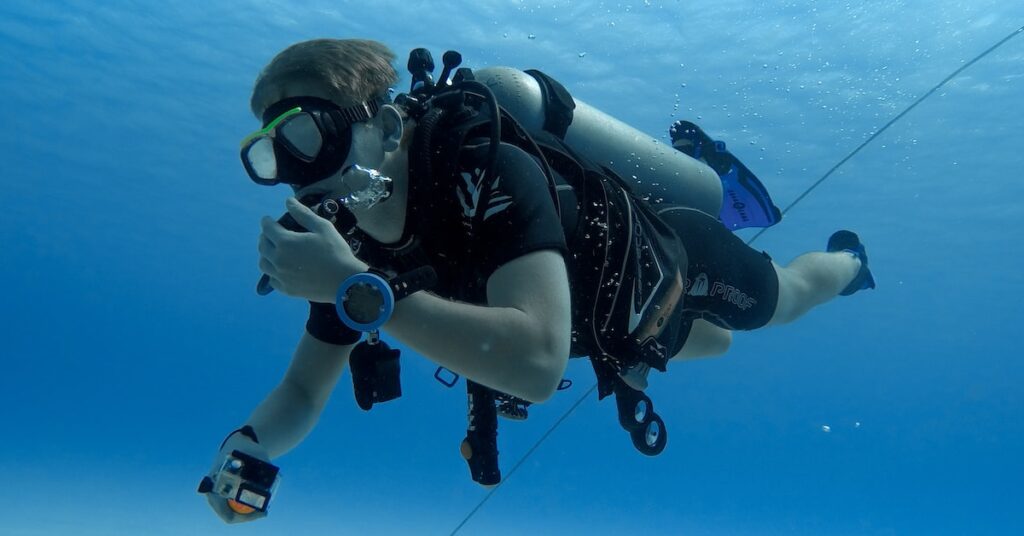

You need a weight belt, or an equivalent weight system for scuba diving. These tools make it easier to descend and find neutral buoyancy, and fast ascents are easier to perform when needed.
Dive weights may seem a bit scary, but they’re just part of a diving system created to get to you to the depth you want to be at – no more and no less. Keep reading to learn about how you can use weights to dive, how much they add on, and how you know you’re carrying the right amount.
Do You Need Weights to Dive?
Along with your weight belt or weight carrying system, you need to carry weights that can help you descent and control your depth.
While drowning is a rational fear, it’s incredibly rare when scuba diving. Your body is naturally buoyant as long as you have air in your lungs, and you’ll tend more towards floating than sinking. This is also more likely if you have more body fat than muscle.
Your diving suit, whether it’s a wetsuit or drysuit, contributes to this positive buoyancy, and it only gets worse the thicker the suit is.
Dive weights add enough negative buoyant weight to your body to give you something to work with to get to certain depths. Using the weights alongside a buoyancy control device (BCD) provides greater control over your dive.
Types of Dive Weight Carrying Systems
Dive weight carrying systems fall into two categories: weight belts or integrated weight systems. Each has their pros and cons, and you may even choose to blend two different systems together.
Weight Belts for Diving
Weight belts are usually just nylon with lead weights that you can thread on. They work like any other belt, allowing you to fasten them around your waist, and they’ve held strong through decades of scuba diving.
You may find variations of weight belts that differ from the generic form. These included:
- Pocket belts
- Lead shot belts
- Brace systems
While weight belts are the most comfortable or effortless way of adding weight, they allow you to drop weight quickly if needed.
Integrated Weight Systems for Diving
Most integrated weight systems tie into your BCD. These weights are often slighter than the lead weights you use with a belt, and they’re more comfortable to wear.
Integrated weight systems feel heavier when you’re moving about when you aren’t diving, and you can’t shed them as easily if you need to make a quick ascent.
How Much Do Dive Weights Weigh?
Modern lead blocks weigh anywhere from 1 to 4 pounds (.45 to 1.81 kg) and are usually coated in plastic to improve corrosion resistance.
Your larger hip weights, which are also curved for a better fit, weigh about 6 to 8 pounds (2.72 to 3.63 kg). Integrated weights come in much smaller because they cannot be dumped easily, and you’ll usually find them at 1 or 2 pounds (.45 to .91 kg).
How Much Weight Do You Need When Scuba Diving?
Most divers carry about 10 percent of their body weight, and this is a great launching off point for most. You can also use an online weight calculator to give you a specific number.
You should not put all of your faith in this number. Because certain variables are always changing, testing your buoyancy prior to your dive is the clearest way to make sure you are properly weighted for your dive.
Factors That Affect How Much Weight You Need
There are certain things that can affect how much weight you need. Some quick details to remember are:
- Saltwater is more buoyant than freshwater.
- Aluminum tanks start off negatively buoyant but become positive when they are empty.
- It’s assumed that larger people need more weight, but those with more muscle mass may actually need less.
- Thicker wetsuits and drysuits require more weight.
Keep your experience in mind when considering weight and the depth of your dive. You should be familiar with your gear and controlling buoyancy before attempting any dive, and more experienced divers can actually get away with less weight by using developed breathing techniques.
How Do I Know I Am Properly Weighted for Diving?
Perform a buoyancy check at the surface to know if you are properly weighted for diving. This should be done with a steel or aluminum tank that is nearly empty.
Once you don all your gear and wear your estimated weight, enter the water and inflate your BCD at the surface. Then, take and hold a normal breath of air (this is the only time you’ll hear anyone advise you to hold your breath when diving).
Empty your BCD completely, and let yourself sink. You should end up with the water at eye level while you are still holding that normal breath of air, then descend as you exhale.
References
https://www.scuba.com/blog/scuba-gear/types-of-scuba-diving-weight-belts/
https://en.wikipedia.org/wiki/Diving_weighting_system
https://aquaworld.com.mx/en/blog/diving-weights-101-how-to-nail-your-buoyancy-calculations/
https://en.wikipedia.org/wiki/Diving_weighting_system
https://www.downtoscuba.com/why-do-we-need-weights-in-scuba-diving/
https://www.downtoscuba.com/i-know-i-am-properly-weighted-for-diving-if-i/
